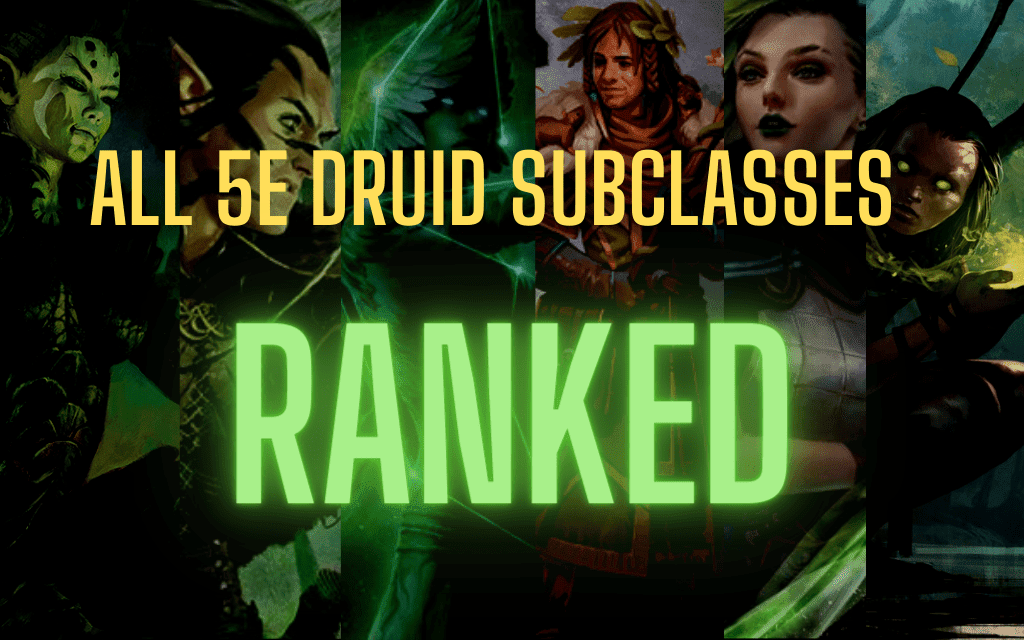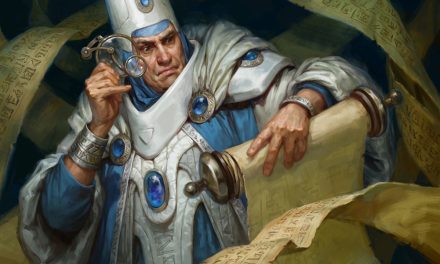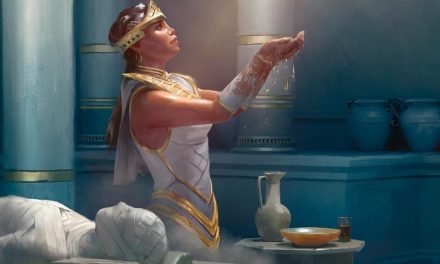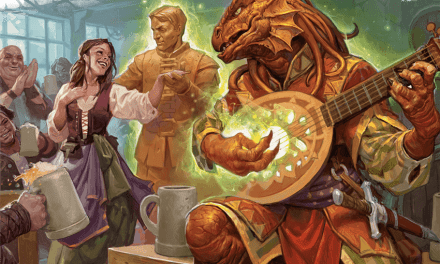The subclass options available to the Druid really showcase the class’s focus on adaptability. Whatever your preferred playstyle may be, at least one of these Druid subclasses are sure to fit your expectation!
However, not all subclasses are created equally.
Using concrete and scientific methods, we have created the most authoritative ranking of the Druid subclasses ever made. There is no opinion here! Just pure data and…
I can’t even write this with a straight face.
At the end of the day, ranking articles are almost purely opinion. However, I do try to be as impartial as possible, and I’ll explain why each subclass ranks as it does.
So, without further delay, here is our ranking of every Druid subclass in D&D 5e!
Number 7 – The Circle of Spores Druid
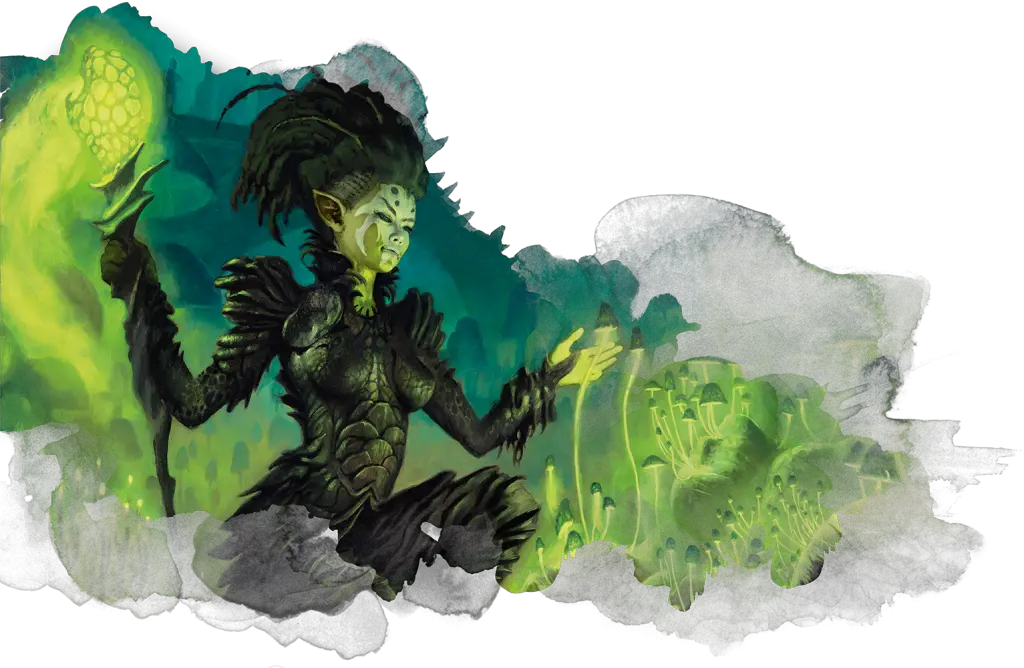
Coming in at spot number 7, we have the Circle of Spores Druid.
If this were a list based purely on flavor, the Circle of Spores Druid would rank towards the top.
It’s definitely interesting to see a take on the Druid that sees them dwelling mostly in melee range without using Wild Shape.
Being able to deal extra damage with their Halo of Spores ability (especially when combined with their Symbiotic Entity ability) is very nice. These Druids are hardy and represent a very unique aspect of the Druid class.
However, this subclass does suffer from some conflicting action economy which is why they rank so low in this list.
Not only do they have to be selective with their spells (as most of the big Druid spells require concentration), but they have two key abilities that are both fighting for the reaction: Halo of Spores and Fungal Infestation.
When I was playing a Circle of Spores Druid, it was always a tough decision on what to use my reaction for.
Without fail, every session I was asking myself at least once: “Do I deal some extra damage with Halo of Spores or hope that a nearby enemy drops before my next turn so I can reanimate them with Fungal Infestation?“
If the enemy doesn’t drop, you could have done some extra damage with Halo of Spores. If you use Halo of Spores, the enemy may drop and you can’t use Fungal Infestation.
While the Circle of Spores isn’t a Shitake-tier pick, it does find itself at the bottom of this list.
(Come on… I had to squeeze at least one mushroom joke in here…)
Become the fungus among us with the full guide for the Circle of Spores!
Number 6 – The Circle of the Land Druid
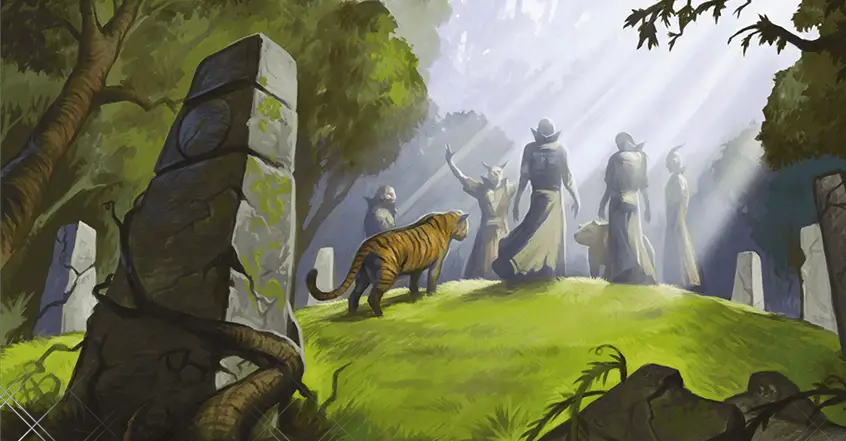
At number 6 on our list, we have the Circle of the Land Druid.
The Circle of the Land Druid excels as the party’s backline spellcaster, much like a Wizard with more focus on natural magic.
These Druids gain loads of extra spells based on the specific environment that they hail from. Desert Druids have more focus on illusion spells, Arctic Druids focus more on control spells, and so on.
The Circle of the Land Druid’s Natural Recovery ability helps them make the most of their available spell slots throughout the adventuring day. Plus, getting a Bonus Cantrip at level 2 is actually very convenient to have!
However, the Circle of the Land Druid works best as a type of niche subclass. If you know that your game’s adventure is going to largely take place in a certain environment, some of the environment’s circle spells become far more useful than they would otherwise be.
Ultimately, it’s this subclass’s late-game abilities that mostly set it back from the others on the list.
They are some very neat and flavorful abilities, but they don’t particularly build on this subclass’s spellcasting strength.
Being immune to fey charms and forcing enemy beasts or plants to roll a Wisdom save when trying to attack you are nice, but not as useful as you would expect high-level subclass abilities to be.
Speak for the trees with the full guide to the Circle of Land Druid!
Number 5 – The Circle of Wildfire Druid
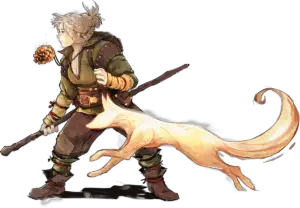
At the root of creation and destruction lies a common force: fire.
The Circle of Wildfire Druid subclass wields the power of fire to unleash devastation on their enemies and heal their allies.
The most important ability for the Circle of Wildfire Druid is their ability to summon a Wildfire Spirit. With this spirit, the Druid is able to boost the power of their spells, teleport themselves and allies short distances, and even bring themselves back to consciousness from 0 hit points.
Furthermore, the Circle of Wildfire Druid gains special Circle Spells that further increase their spellcasting power.
At this point in the ranking, we’re looking at Druid subclasses that stand as pretty solid B-tier choices. Honestly, the only thing that stops the Circle of Wildfire Druid from ranking higher on this list is that I wish they had access to the Fireball spell.
Set the battlefield ablaze with our guide to the Circle of Wildfire Druid!
Number 4 – The Circle of Dreams Druid
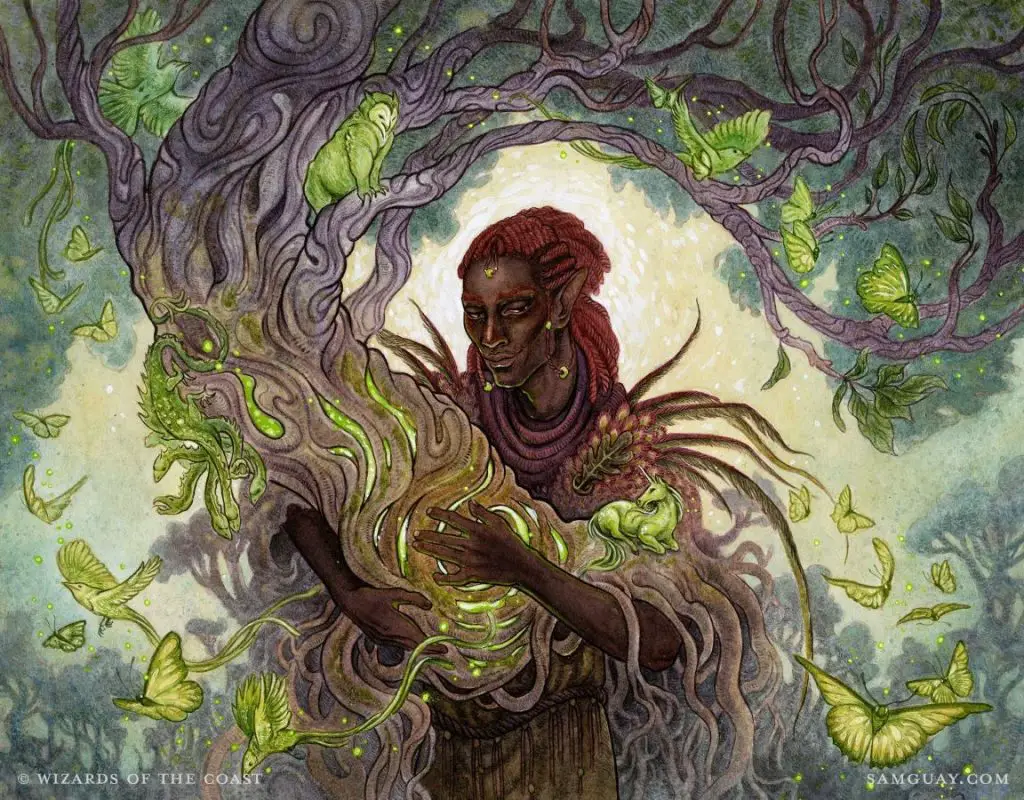
For those who enjoy frolicking with fey in the realms between Dreams and Reality, we have the Circle of Dreams Druid subclass.
These Druids are tied to the Feywild and the dreamlike realms that can be found there. As a calming presence for any party, the Circle of Dreams focuses heavily on their healing abilities and being able to make quick exits when necessary.
Balm of the Summer Court is an incredible ability that scales very well as you continue to gain levels in this class. Being able to use a bonus action to heal an ally within 120 feet of you and give them temporary hit points as an ability (not a spell) is fantastic.
Additionally, the Hidden Paths ability gained at level 10 is marvelously useful. Using a bonus action to teleport yourself or an ally across the battlefield is endlessly useful. It’s effectively a better version of Misty Step that doesn’t eat up spell resources.
Despite being my personal favorite of the Druid subclasses, the Circle of Dreams still finds itself in that “high end of B-tier, low end of A-tier” type placement.
The healing and utility that the Circle of Dreams Druid offers is genuinely impressive, but it’s almost not even fair to hold it up to the standard of our top 3 Druid subclasses!
Bring some Fey support to your team with our full guide to the Circle of Dreams Druid!
Number 3 – The Circle of the Shepherd Druid
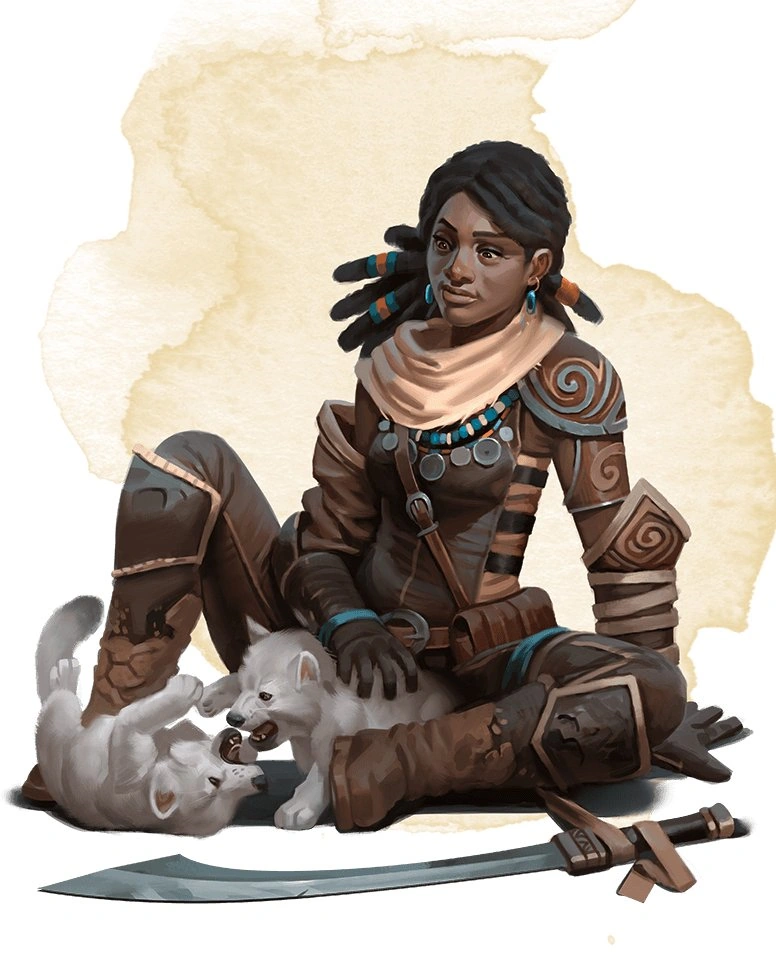
The Circle of the Shepherd Druid subclass stands apart from the other Druid subclass options as the undisputed summoner and buffer.
I’m going to be frank, it’s downright disgusting what this subclass is capable of.
The general strategy for the Circle of the Shepherd Druid is to summon a bunch of allies, buff them (and the rest of the party) with a Spirit Totem, and dogpile the enemy.
As the Druid levels up, the creatures summoned by the Druid get stronger and can stay in the fight longer. Not only do you have some major meatshields to take damage for the party, but you can overwhelm enemies with a sheer numbers advantage.
Realistically, the Circle of the Shepherd can even outperform the Circle of Dreams Druid when it comes to healing if their allies are close enough to their Unicorn Spirit Totem. This means that they can also fill a vital support role for the party as well!
If the Circle of the Shepherd is able to conjure animals or fey to help them out and maintain their concentration, they’re virtually unstoppable.
The Circle of the Shepherd Druid sits pretty firmly in the A-tier for Druid subclasses.
The only reason that I wouldn’t quite qualify it as an S-tier subclass is because of the nature of summoning magic. Namely, the DM generally tells you what is summoned. However, in the vast majority of groups that I have played in or DM’d for, it’s left up to the caster to decide what gets summoned.
If you can pick your own summons, this is easily in the S-tier. If you can’t, it’s still incredibly powerful.
Discover why there’s strength in numbers with our guide to the Circle of the Shepherd Druid!
Number 2 – The Circle of Stars Druid
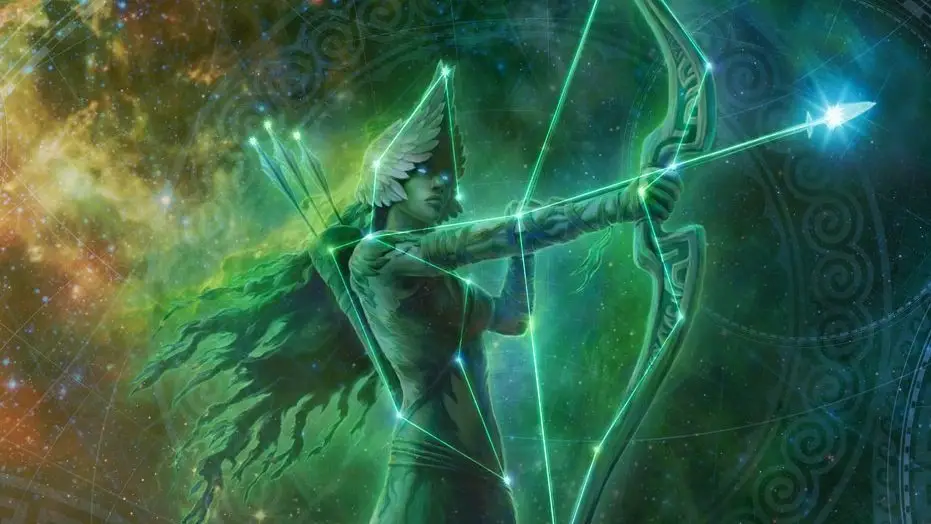
As we approach the end of this ranking, the number 2 spot goes to what might be the most creatively inspired of the Druid subclasses.
The Circle of Stars Druid finds their power hidden within the constellations. With their trusty Star Map as a spellcasting focus, these Druids pull their power from the universe itself.
Right from the get-go, the Circle of Stars Druid gets the Guidance cantrip (a major must-have) and Guiding Bolt spell for free. Even better, they can cast Guiding Bolt without using a spell slot!
But the big draw to this subclass is the Starry Form ability.
With Starry Form, the Druid chooses one of three forms (Archer, Chalice, or Dragon) and gains special abilities based on that choice.
Want to fire some extra damage at enemies using only a bonus action? Become a celestial archer!
Need to pull out some clutch healing to keep your party in the fight? The Chalice has you covered!
Worried about losing concentration in battle? Channel the wisdom of the Dragon constellation!
But the Circle of Stars keeps getting better!
The Circle of Stars Druid gets daily Cosmic Omens of Weal or Woe to aid their party. These omens add to rolls by allies and can subtract from rolls made by enemies.
As you continue to level, you’ll gain resistance to melee attacks, buffs to all of your Starry Forms, and the ability to change your Starry Form within a single use of the ability.
For its flavor, mechanics, and all-around ability to bring out the best of the Druid’s roles in the party, I consider the Circle of Stars to be an S-tier subclass.
Harness the power of the heavens with our guide to the Circle of Stars Druid!
Number 1 – The Circle of the Moon Druid
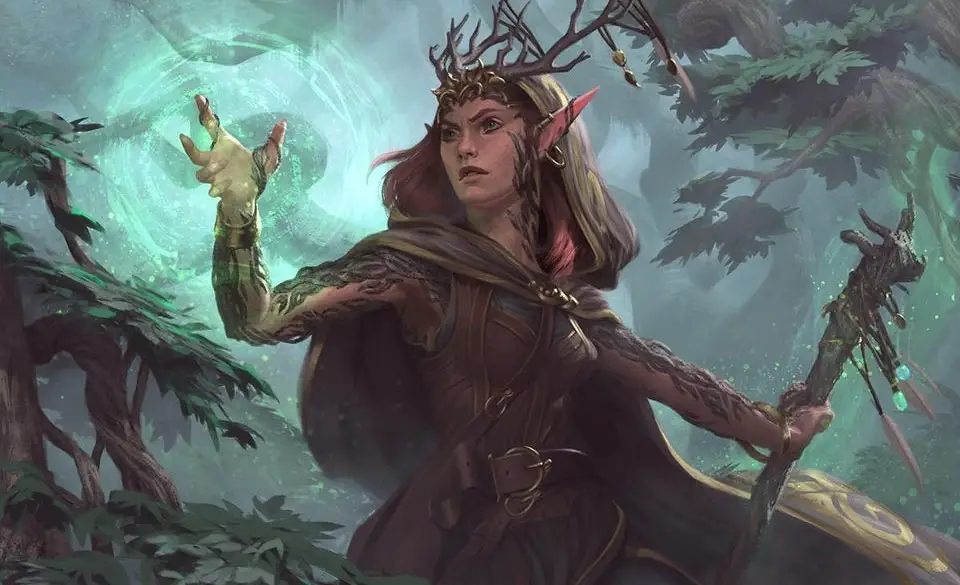
While it’s probably not surprising to find the Circle of the Moon at the very top of this ranking, it certainly earns it!
This is, in my opinion, the absolutely quintessential Druid class.
The Circle of the Moon Druid uses their shapeshifting abilities to lay waste to enemies while also providing countless utilities to aid their party.
Whether your party needs a bear for combat, a shark for swimming, a rat for scouting, or anything else, the Circle of the Moon has got it covered.
Of all of the Druid subclasses, I think that this one can be the most intimidating at first. I mean, no other class in the game pretty much requires you to have an entire other book (the Monster Manual) to play it!
But when you figure out the ins-and-outs of your Wild Shape ability, the possibilities are endless. (Speaking of which, I do recommend checking out the Wild Shape guide if you’re wanting to play a Circle of the Moon Druid!)
Not only does the Circle of the Moon Druid get the ability to turn into stronger beasts at lower levels, but they can turn into creatures that no other Druid can! From beasts like the fearsome Giant Scorpion to the sheer power of Elementals, the Circle of the Moon Druid stays strong for the entire game.
Oh, and a level 20 Circle of the Moon Druid is basically incapable of being killed thanks to their unlimited uses of Wild Shape.
As fans of Critical Role may well remember from the Season 1 Epic Battle Royale, Keyleth (the party’s Druid) used each turn to Wild Shape into a new high-hp elemental with a whole new set of hit points!
For their endless utility, strength, and all-around awesomeness, the Circle of the Moon Druid takes the top spot in the Druid subclasses ranking.
Get wild with our guide to the Circle of the Moon Druid!
Conclusion – Ranking the Druid Subclasses of D&D 5e
One of my favorite things about the Druid subclasses in D&D 5e is just how unique each one is. Each brings a great deal of flavor and function to the table.
So, what do you think about this ranking? Would you rank the Druid subclasses differently?
Let’s chat in the comments!
Also, don’t forget to check out our Complete Druid Guide for D&D 5e! It covers everything you need to fully channel the power of nature on your adventures!
You can find the Circle of the Moon and Land Druids in the 5e Player’s Handbook.
The Circle of Dreams and Circle of the Shepherd both appear in Xanathar’s Guide to Everything.
Get the Circle of Spores, Circle of Wildfire, and Circle of Stars Druids in Tasha’s Cauldron of Everything.

